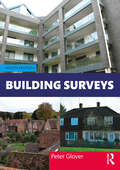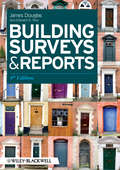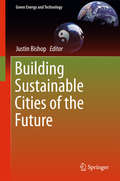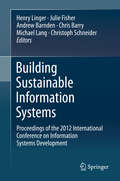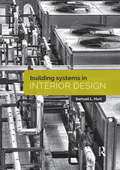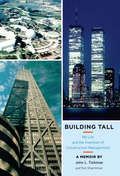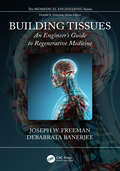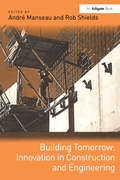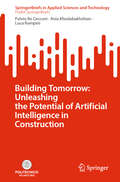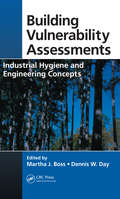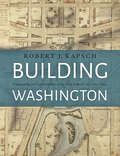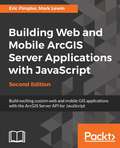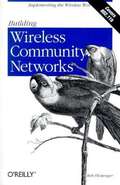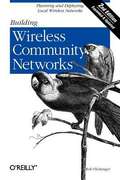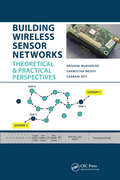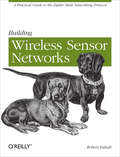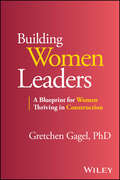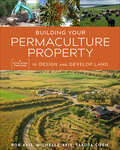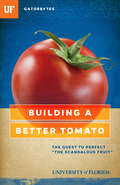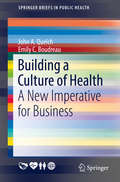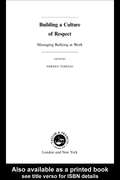- Table View
- List View
Building Surveys
by Peter GloverBuilding Surveys has been a trusted guide for both students and professionals for nearly 40 years, evolving throughout its nine editions to address the challenges and responsibilities of the building surveying role. It covers everything needed for initial inspections such as equipment, know-how and procedures to writing an accurate report, making it indispensable to those practising in or studying this field. • This updated Ninth Edition features new material on modern methods of construction, new sustainable materials, new surveying technologies and industry developments in the wake of the Grenfell Fire. • Essential reading for building construction students, professional surveyors and others who may be required to inspect and report on buildings. • Illustrated throughout with colour photos showing examples of building defects in full detail. All the structural aspects of property surveying are explained, covering foundations, walls and roofs as well as what to look out for and how to deal with problems. Materials and techniques no longer in use are covered as well as new technologies, so the reader is prepared for anything they might encounter. Legal considerations and recent cases are also used to illustrate good working practice, making this an extremely practical companion to the subject.
Building Surveys and Reports
by James DouglasThis book provides guidance on building survey work for typical residential, commercial and industrial buildings, with advice on how to diagnose a wide range of defects. It considers both modern and older construction methods, together with new and traditional materials. The particular problems of alteration and renovation work are discussed, with guidance on how to carry out measured surveys. A separate chapter covers survey problems after flood and fire damage, and the legal section takes account of recent developments in case law relating to inspections and surveys of properties. This new edition continues to provide a thorough treatment of all the key issues relating to surveying buildings, dealing with the problems that surveyors are likely to encounter when inspecting buildings. Changes for the new edition include: Examples and references have been updated Evaluation of condition rating systems for domestic and commercial buildings A new section on the home condition reports More information on slate defects Bibliography revised and expanded, to make it more comprehensive Additional appendix showing the home condition report format
Building Sustainable Cities of the Future (Green Energy and Technology)
by Justin BishopThis book draws upon the expertise of academic researchers, urban planners and architects to explore the challenge of building the sustainable cities of the future. It addresses this challenge by considering current cities and those of the near future, and creates a picture of the sustainable city from the bottom up. Individual chapters cover topics such as transport, energy supply, sustainable urbanism and promoting social equality in large infrastructure projects. Real-world examples are presented to illustrate how systems thinking is used to integrate different components of a city so as to ensure that the whole is more sustainable than its parts. Written in an accessible style, this book is intended for general readers as much as it is for students and researchers interested in sustainable cities and related topics. It is also ideal for urban planners seeking best-practice guidelines for sustainable urban development.
Building Sustainable Information Systems: Proceedings Of The 2012 International Conference On Information Systems Development
by Michael Lang Christoph Schneider Chris Barry Henry Linger Julie Fisher Andrew BarndenInformation Systems (IS) as a discipline draws on diverse areas including, technology, organisational theory, management and social science. The field is recognized as very broad and encompassing many themes and areas. However, the development of artefacts, or information systems development (ISD), in the broadest sense, is a central concern of the discipline. Significantly, ISD impacts on the organisational and societal contexts through the use of the artefacts constructed by the development. Today, that impact also needs to be evaluated in terms of its effects on the environment. Sustainable, or "green," IT is a catch-all term used to describe the development, manufacture, management, use and disposal of ICT in a way that minimizes damage to the environment. As a result, the term has many different meanings, depending on the role assumed in the life span of the ICT artefact. The theme of the proposed work is to critically examine the whole range of issues around ISD from the perspective of sustainability. Sustainable IT is an emerging theme in academic research and industry practice in response to an individual concern for the environment and the embryonic regulatory environments being enacted globally to address the environmental impact of ICT. In this work we intend to bring together in one volume the diverse research around the development of sustainable IS.
Building Systems in Interior Design
by Samuel L. Hurt<p>Building Systems in Interior Design takes an entirely new approach to teaching this essential topic for Architects, Designers and Building Engineers. Written to prepare students for the real world and packed with practical examples, the book will foster an understanding of specific issues that are critical to those features of technical systems that most directly affect design. The book stresses the ever-present nature of these systems: they are everywhere, all the time. <p>Taking a design oriented view, it outlines what can and cannot be done, and provides the student with the know-how and confidence to defend and promote their design intent when working with other industry professionals. <p>Covering lighting, HVAC, plumbing and much more, the book is packed with key features to aid learning including: <p> <li>Numerous illustrations, plans and photographs <li>Key terms defined in an extensive glossary <li>Chapter introductions that identify key concepts and chapter summaries to re-visit those key concepts <li>Professional design tips <li>And a detailed bibliography and web links</li> <p> <p>This book is not only a core text for interior design, building systems engineering and architecture students but will become an essential working reference through their careers.</p>
Building Tall: My Life and the Invention of Construction Management
by Tom Shachtman John L. TishmanIn this memoir, University of Michigan graduate John L. Tishman recounts the experiences and rationale that led him to create the entirely new profession now recognized and practiced as Construction Management. It evolved from his work as the construction lead of the "owner/builder" firm Tishman Realty and Construction, and his personal role as hands-on Construction Manager in the building of an astonishing array of what were at the time the world's tallest and most complex projects.
Building Technology Transfer within Research Universities
by Thomas J. Allen Rory P. O'SheaFor the past number of years, academic entrepreneurship has become one of the most widely studied topics in the entrepreneurship literature. Yet, despite all the research that has been conducted to date, there has not been a systematic attempt to analyze critically the factors which lie behind successful business spin-offs from university research. In this book, a group of academic thought-leaders in the field of technology transfer examine a number of areas critical to the promotion of start-ups on campus. Through a series of case studies, they examine current policies, structures, program initiatives and practices of fourteen international universities to develop a theory of successful academic entrepreneurship, with the aim of helping other universities to enhance the quality of their university transfer programs. This book is a valuable resource for researchers and graduate students working on innovation, entrepreneurship and technology transfer, as well as senior managers and policymakers.
Building Thermal Performance and Sustainability (Lecture Notes in Civil Engineering #316)
by Vijayalaxmi J.This book highlights the various aspects of architectural research based on field studies and real-time data including the data collection methods and the methodology and materials required. The output of every study is knowledge based and informed decision that helps architects and designers in decision making process at an early stage. The output of the book bridges the architectural research methods and its application in contemporary world through a thorough understanding of sustainable building materials, construction techniques and its quantified consequences on thermal performance. This book is aimed at researchers and professionals to assist in understanding the strategies, tacts and methods of a scientific approach to assess building performance through real-life case studies from India. The implication of what is being done in the contemporary world is highlighted which will help practicing architects make design decisions.
Building Tissues: An Engineer's Guide to Regenerative Medicine (Biomedical Engineering)
by Joseph W. Freeman Debabrata BanerjeeTissue engineering uniquely applies concepts and techniques from biology and engineering in order to heal or produce new tissues after disease or traumatic injury. A successful tissue engineer must have knowledge of cellular biology, cell signaling, extracellular matrix development, and tissue structure and integrate it with the application of stresses and strains, mass transfer, mechanical properties, and heat transfer. In order to train the next generation of successful tissue engineers, this text gives the reader a background in both the engineering and biology associated with tissue engineering.
Building Tomorrow: Innovation in Construction and Engineering
by André ManseauIn the past decade construction and engineering have changed dramatically, with an explosion of innovative new approaches to construction and new methodologies. By bringing together economic, social and construction/engineering management perspectives, this book offers a unique and comprehensive survey of these approaches and techniques. It presents a history of studies in innovation in construction and engineering, and then presents the most recent models of innovation brokering and risk-management, based on complex project-based industries. Innovation is defined and competing theories are discussed in the light of operational issues. The book covers all aspects, including the importance of construction and engineering 'cultures' in the trades for successful project innovation. It also discusses the role of government and policy makers, the implications of rapid change for the building trades and skilled labour, and the difficulty of measuring innovation quantitatively.
Building Tomorrow: Unleashing the Potential of Artificial Intelligence in Construction (SpringerBriefs in Applied Sciences and Technology)
by Fulvio Re Cecconi Ania Khodabakhshian Luca RampiniThis book explores the transformative impact of artificial intelligence (AI) on the construction industry, examining its readiness for widespread integration and its potential to reshape various facets of the construction lifecycle. It introduces the concept of a readiness metric tailored to the construction sector, providing a comprehensive framework for assessing and improving AI adoption. The narrative then shifts to the early stages of projects, highlighting the role of AI in promoting sustainability. From leveraging open data for data-driven decisions to using machine learning for strategic decisions in retrofitting and decarbonising the built environment, the book investigates how AI can be a catalyst for positive change in the construction process. It then explores the integration of AI into project and risk management, unlocking the potential of advanced analytics and predictive modelling to streamline processes and improve decision-making, and the application of AI in asset and facility management, highlighting how intelligent technologies can optimise the lifecycle of built assets. Examining the responsible use of AI tools, the book addresses ethical challenges and outlines guidelines for the conscientious and equitable integration of AI into the construction ecosystem. Overall, it serves as a comprehensive guide for industry professionals, researchers, and policymakers, providing insights into the current landscape, the potential of AI, and the ethical considerations necessary for responsible implementation.
Building Vulnerability Assessments: Industrial Hygiene and Engineering Concepts
by Martha J. Boss Dennis W. DayAll too often the assessment of structural vulnerability is thought of only in terms of security upgrades, guards, and entrance barriers. However, in order to fully ensure that a building is secure, the process of design and construction must also be considered. Building Vulnerability Assessments: Industrial Hygiene and Engineering Concepts focuses
Building Washington: Engineering and Construction of the New Federal City, 1790−1840
by Robert J. KapschA richly illustrated behind-the-scenes tour of how the nation’s capital was built.In 1790, George Washington and Thomas Jefferson set out to build a new capital for the United States of America in just ten years. The area they selected on the banks of the Potomac River, a spot halfway between the northern and southern states, had few resources or inhabitants. Almost everything needed to build the federal city would have to be brought in, including materials, skilled workers, architects, and engineers. It was a daunting task, and these American Founding Fathers intended to do it without congressional appropriation.Robert J. Kapsch’s beautifully illustrated book chronicles the early planning and construction of our nation’s capital. It shows how Washington, DC, was meant to be not only a government center but a great commercial hub for the receipt and transshipment of goods arriving through the Potomac Canal, then under construction. Picturesque plans would not be enough; the endeavor would require extensive engineering and the work of skilled builders. By studying an extensive library of original documents—from cost estimates to worker time logs to layout plans—Kapsch has assembled a detailed account of the hurdles that complicated this massive project. While there have been many books on the architecture and planning of this iconic city, Building Washington explains the engineering and construction behind it.
Building Web and Mobile ArcGIS Server Applications with JavaScript – Second Edition
by Eric Pimpler<P><P>Master the ArcGIS API for JavaScript to build web and mobile applications using this practical guide. <P><P>About This Book <P><P>Develop ArcGIS Server applications with JavaScript, both for traditional web browsers as well as the mobile platform <P><P>Make your maps informative with intuitive geographic layers, user interface widgets, and more <P><P>Integrate ArcGIS content into your custom applications and perform analytics with the ArcGIS Online <P><P>Who This Book Is For <P><P>If you are a web or mobile application developer, who wants to create GIS applications in your respective platform, this book is ideal for you. You will need Java Script programming experience to get the most out of this book. Although designed as an introductory to intermediate level book, it will also be useful for more advanced developers who are new to the topic of developing applications with ArcGIS Server. <P><P>What You Will Learn <P><P>To create an application with the ArcGIS API for JavaScript <P><P>Build and display a broad range of different geometry types to represent features on the map <P><P>The best way to leverage a feature layer and display related attribute data <P><P>The functionality of the wide range of widgets and how to use them effectively <P><P>Query data to gain new insights into the information it contains <P><P>Work with tasks to discover and locate features on the map <P><P>Using the geocoder and associated widgets <P><P>The ability of the API to provide turn by turn directions and routing capabilities <P><P>How to use the Geometry Engine and Geometry Service tasks for common geoprocessing operations <P><P>Integrate content on ArcGIS online and add it to your custom web mapping application <P><P>In Detail <P><P>The ArcGIS API for JavaScript enables you to quickly build web and mobile mapping applications that include sophisticated GIS capabilities, yet are easy and intuitive for the user. <P><P>Aimed at both new and experienced web developers, this practical guide gives you everything you need to get started with the API. After a brief introduction to HTML/CSS/JavaScript, you'll embed maps in a web page, add the tiled, dynamic, and streaming data layers that your users will interact with, and mark up the map with graphics. You will learn how to quickly incorporate a broad range of useful user interface elements and GIS functionality to your application with minimal effort using prebuilt widgets. As the book progresses, you will discover and use the task framework to query layers with spatial and attribute criteria, search for and identify features on the map, geocode addresses, perform network analysis and routing, and add custom geoprocessing operations. Along the way, we cover exciting new features such as the client-side geometry engine, learn how to integrate content from ArcGIS.com, and use your new skills to build mobile web mapping applications. <P><P>We conclude with a look at version 4 of the ArcGIS API for JavaScript (which is being developed in parallel with version 3.x) and what it means for you as a developer. <P><P>Style and approach <P><P>Readers will be taken through a series of exercises that will demonstrate how to efficiently build ArcGIS Server applications for the mobile and web.
Building Wireless Community Networks
by Rob FlickengerBuilding Wireless Community Networksoffers a compelling case for building wireless networks on a local level: They are inexpensive, and they can be implemented and managed by the community using them, whether it's a school, a neighborhood, or a small business. This book also provides all the necessary information for planning a network, getting the necessary components, and understanding protocols that you need to design and implement your network.
Building Wireless Community Networks, 2nd Edition
by Rob FlickengerBuilding Wireless Community Networks is about getting people online using wireless network technology. The 802.11b standard (also known as WiFi) makes it possible to network towns, schools, neighborhoods, small business, and almost any kind of organization. All that's required is a willingness to cooperate and share resources. The first edition of this book helped thousands of people engage in community networking activities. At the time, it was impossible to predict how quickly and thoroughly WiFi would penetrate the marketplace. Today, with WiFi-enabled computers almost as common as Ethernet, it makes even more sense to take the next step and network your community using nothing but freely available radio spectrum. This book has showed many people how to make their network available, even from the park bench, how to extend high-speed Internet access into the many areas not served by DSL and cable providers, and how to build working communities and a shared though intangible network. All that's required to create an access point for high-speed Internet connection is a gateway or base station. Once that is set up, any computer with a wireless card can log onto the network and share its resources. Rob Flickenger built such a network in northern California, and continues to participate in network-building efforts. His nuts-and-bolts guide covers: Selecting the appropriate equipment Finding antenna sites, and building and installing antennas Protecting your network from inappropriate access New network monitoring tools and techniques (new) Regulations affecting wireless deployment (new) IP network administration, including DNS and IP Tunneling (new) His expertise, as well as his sense of humor and enthusiasm for the topic, makes Building Wireless Community Networks a very useful and readable book for anyone interested in wireless connectivity.
Building Wireless Community Networks, Second Edition
by Rob FlickengerBuilding Wireless Community Networks is about getting people online using wireless network technology. The 802.11b standard (also known as WiFi) makes it possible to network towns, schools, neighborhoods, small business, and almost any kind of organization. All that's required is a willingness to cooperate and share resources. The first edition of this book helped thousands of people engage in community networking activities. This revised and expanded edition adds coverage on new network monitoring tools an
Building Wireless Sensor Networks: Theoretical and Practical Perspectives
by Nandini Mukherjee Sarmistha Neogy Sarbani RoyBuilding Wireless Sensor Networks: Theoretical and Practical Perspectives presents the state of the art of wireless sensor networks (WSNs) from fundamental concepts to cutting-edge technologies. Focusing on WSN topics ideal for undergraduate and postgraduate curricula, this book: Provides essential knowledge of the contemporary theory and practice of wireless sensor networking Describes WSN architectures, protocols, and operating systems Details the routing and data aggregation algorithms Addresses WSN security and energy efficiency Includes sample programs for experimentation The book offers overarching coverage of this exciting field, filling a critical gap in the existing literature.
Building Wireless Sensor Networks: with ZigBee, XBee, Arduino, and Processing
by Robert FaludiGet ready to create distributed sensor systems and intelligent interactive devices using the ZigBee wireless networking protocol and Series 2 XBee radios. By the time you're halfway through this fast-paced, hands-on guide, you'll have built a series of useful projects, including a complete ZigBee wireless network that delivers remotely sensed data.Radio networking is creating revolutions in volcano monitoring, performance art, clean energy, and consumer electronics. As you follow the examples in each chapter, you'll learn how to tackle inspiring projects of your own. This practical guide is ideal for inventors, hackers, crafters, students, hobbyists, and scientists.Investigate an assortment of practical and intriguing project ideasPrep your ZigBee toolbox with an extensive shopping list of parts and programsCreate a simple, working ZigBee network with XBee radios in less than two hours -- for under $100Use the Arduino open source electronics prototyping platform to build a series of increasingly complex projectsGet familiar with XBee's API mode for creating sensor networksBuild fully scalable sensing and actuation systems with inexpensive componentsLearn about power management, source routing, and other XBee technical nuancesMake gateways that connect with neighboring networks, including the Internet
Building Women Leaders: A Blueprint for Women Thriving in Construction
by Gretchen Gagel“In the decades I’ve known Gretchen, I have watched her grow and excel as a mother, a civic and business leader, and an influencer in the construction industry. We are so fortunate that Gretchen carved out the time to write this seminal book on women’s leadership and I am confident that all will benefit from the knowledge she shares. Gretchen is a remarkable leader and role model who cares deeply for the construction industry, and her passion for helping women thrive helps us build a more inclusive industry.” —Mary K. Rhinehart, Chair, Johns Manville Corporation. Practical leadership guidance, inspiring stories, and actionable strategies for women and their male allies to elevate their careers in construction Building Women Leaders: A Blueprint for Women Thriving in Construction is a guide to becoming a successful female leader in the construction, engineering, mining, and energy industries. Featuring real-world case studies, inspiring stories of successful women leaders, and actionable strategies, this book serves as a catalyst for transformation, enabling organizations to harness the untapped potential of their female talent and drive innovation and growth. Leveraging the author’s 40-year industry career as a construction industry executive, female trailblazer, and advocate for women empowerment in the workplace, Building Women Leaders includes information on: Techniques for navigating a male-dominated industry, including understanding “dominant culture” and unconscious biasThe qualities of successful leaders in these industries, including what it means to lead versus manage and how Grounded Self-leadership is critical to authenticityGuidelines for building strong relationships and leading a diverse team with confidence, courage, and humilityWays to handle difficult conversations and conflicts, and the role of trust and vulnerability in these situationsHow to build support via professional organizations, networking groups, and training and development opportunities for women leaders Building Women Leaders is a timely, essential, up-to-date resource on the subject for leaders of all genders and at all levels and occupations in the engineering, construction, mining, and energy industries looking to harness the power of women in the workforce.
Building Your Permaculture Property: A Five-Step Process to Design and Develop Land (Mother Earth News Wiser Living Ser.)
by Rob Avis Michelle Avis Takota Coen&“A fresh, integrative, and holistic perspective on how to orientate oneself to the process of establishing your dreams and visions on the land.&” —Richard Perkins, author of Regenerative AgricultureBuilding Your Permaculture Property offers a revolutionary holistic method to overcome overwhelm in the complex process of resilient land design. It distills the authors&’ decades of experience as engineers, farmers, educators, and consultants into a five-step process complete with principles, practices, templates, and workflow tools to help you: Clarify your vision, values, and resources Diagnose your land and resources for strengths, weaknesses, opportunities, and threats Design your land and resources to meet your vision and values Implement the right design to enhance your strengths and improve your weakest resource Establish benchmarks to monitor the sustainability and success of your development. When designing a regenerative permaculture property, too many land stewards suffer from option paralysis, a lack of integrated holistic design, fruitless trial-and-error attempts, wasted money, and the frustration that results from too much information and no context.Building Your Permaculture Property is the essential guide for everyone looking to cut through the noise and establish an ecologically regenerative, financially sustainable, enjoyable, and thriving permaculture property, anywhere in the world. &“Highlights the need for permaculture design thinking in creating resilient, regenerative, landscapes and communities. Through this work, Rob, Michelle, and Takota make a valuable contribution to the ongoing evolution of permaculture thinking and action.&” —David Holmgren, permaculture co-originator &“Every farm, every ranch, and every homestead can benefit from thinking deeper about how human intent engages with the places we&’re blessed to call home.&” —Michael Phillips, author of The Holistic Orchard
Building a Better Tomato: The Quest to Perfect "The Scandalous Fruit"
by Jeff Klinkenberg University of FloridaIn the search for a superior alternative to bland and mealy grocery-store tomatoes, horticultural scientist Harry Klee and renowned taste researcher Linda Bartoshuk teamed up and are hot on the trail of a specimen that will have you thinking you just picked it in your own back yard. Gatorbytes highlight for the intellectually curious the world of innovative research happening at the University of Florida. Written by professional journalists, Gatorbytes feature the top research and preeminence work being conducted at the University of Florida, written in a way that’s easy to understand.
Building a Better World: From Toys to Tools (Fountas & Pinnell Classroom, Guided Reading Grade 5)
by Nicole WalkerOutside the Box It's safe to say that people everywhere enjoy building things using LEGO kits, blocks, or a combination of many toys. Then there are those who think outside the box. They are people who have used toys to improve the lives of others. NIMAC-sourced textbook
Building a Culture of Health: A New Imperative for Business (SpringerBriefs in Public Health)
by John A. Quelch Emily C. BoudreauThis ambitious volume sets out to understand how every company impacts public health and introduces a robust model, rooted in organizational and scientific knowledge, for companies committed to making positive contributions to health and wellness. Focusing on four interconnected areas of corporate impact, it not only discusses the business imperative of promoting a healthier society and improved living conditions worldwide, but also provides guidelines for measuring a company's population health footprint. Examples, statistics and visuals showcase emerging corporate involvement in public health and underscore the business opportunities available to companies that invest in health. The authors offer a detailed roadmap for optimizing health-promoting actions in a rapidly evolving business and social climate across these core areas: Planning and building a culture of health Consumer health: How organizations affect the safety, integrity, and healthfulness of the products and services they offer to their customers and end consumers Employee health: How organizations affect the health of their employees (e. g. , provision of employer-sponsored health insurance, workplace practices and wellness programs) Community health: How organizations affect the health of the communities in which they operate and do business Environmental Health: How organizations' environmental policies (or lack thereof) affect individual and population health Implementing and sustaining a culture of health Building a Culture of Health clarifies both a mission and a vision for use by MPH and MBA students in health management, professors in schools of public health and business schools, and business leaders and chief medical officers in health care and non-health care businesses.
Building a Culture of Respect: Managing Bullying at Work
by Noreen TehraniBullying is an increasing problem in the workplace. It is estimated that five million workers are bullied each year in the UK, and that one in four employees is aware of colleagues being bullied. Bullying creates significant health problems for employees and, despite this, there is a conspicuous absence of published material on why these behaviors
